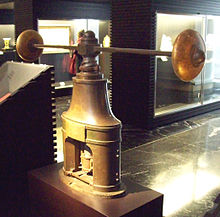
A coining press is a manually operated machine that mints coins from planchets. After centuries it was replaced by more modern machines.
Presses came in multiple shapes and with different accessories (to collect the coins, etc.) They were made of cast iron. The basic elements are:[1][2][3]
- A triumphal arch with a built-in base
- A vertically arranged leadscrew that supported an inertia wheel or more commonly, a piece made up of two radial arms with weights at the ends.
- The leadscrew (male) rotates inside a threaded (female) nut. The nut is attached to the structure. The turn of the inertia wheel (or bar with weights) determines the rotation of the thread bar and its vertical displacement (up or down depending on the direction of rotation).
- Vertical guides allow vertical displacement of the holder (upper die) without rotating.
- ^ Joaquim Botet i Sisó; Joaquim Botet y Sisó (1997). Obra numismàtica esparsa i inèdita de Joaquim Botet i Sisó. Institut d'Estudis Catalans. pp. 103–. ISBN 978-84-7283-379-1.
- ^ Notícia del volum tercer del "Tratado de las monedas labradas en el Principado de Cataluña por el Dr. D. Josef Salat"
- ^ Jean Boizard (1711). Traité des monoyes, de leurs circonstances & dépendances. Chez Jacques Le Febvre. p. 145.